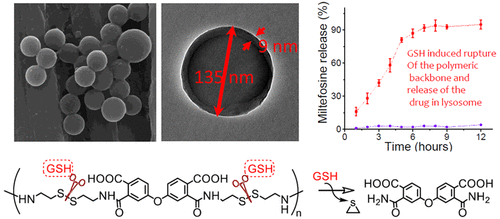当前位置:
X-MOL 学术
›
Bioconjugate Chem.
›
论文详情
Our official English website, www.x-mol.net, welcomes your
feedback! (Note: you will need to create a separate account there.)
Redox-Responsive Nanocapsules for the Spatiotemporal Release of Miltefosine in Lysosome: Protection against Leishmania
Bioconjugate Chemistry ( IF 4.0 ) Pub Date : 2021-01-13 , DOI: 10.1021/acs.bioconjchem.0c00667 Rajeshwari Tiwari 1, 2 , Saswati Banerjee 3 , Deepak Tyde 1, 2 , Krishna Das Saha 3 , Anitha Ethirajan 4 , Niladri Mukherjee 3 , Samit Chattopadhy 5 , Sumit Kumar Pramanik 1, 2 , Amitava Das 6
Bioconjugate Chemistry ( IF 4.0 ) Pub Date : 2021-01-13 , DOI: 10.1021/acs.bioconjchem.0c00667 Rajeshwari Tiwari 1, 2 , Saswati Banerjee 3 , Deepak Tyde 1, 2 , Krishna Das Saha 3 , Anitha Ethirajan 4 , Niladri Mukherjee 3 , Samit Chattopadhy 5 , Sumit Kumar Pramanik 1, 2 , Amitava Das 6
Affiliation

|
Leishmaniasis, a vector-borne disease, is caused by intracellular parasite Leishmania donovani. Unlike most intracellular pathogens, Leishmania donovani are lodged in parasitophorous vacuoles and replicate within the phagolysosomes in macrophages. Effective vaccines against this disease are still under development, while the efficacy of the available drugs is being questioned owing to the toxicity for nonspecific distribution in human physiology and the reported drug-resistance developed by Leishmania donovani. Thus, a stimuli-responsive nanocarrier that allows specific localization and release of the drug in the lysosome has been highly sought after for addressing two crucial issues, lower drug toxicity and a higher drug efficacy. We report here a unique lysosome targeting polymeric nanocapsules, formed via inverse mini-emulsion technique, for stimuli-responsive release of the drug miltefosine in the lysosome of macrophage RAW 264.7 cell line. A benign polymeric backbone, with a disulfide bonding susceptible to an oxidative cleavage, is utilized for the organelle-specific release of miltefosine. Oxidative rupture of the disulfide bond is induced by intracellular glutathione (GSH) as an endogenous stimulus. Such a stimuli-responsive release of the drug miltefosine in the lysosome of macrophage RAW 264.7 cell line over a few hours helped in achieving an improved drug efficacy by 200 times as compared to pure miltefosine. Such a drug formulation could contribute to a new line of treatment for leishmaniasis.
中文翻译:

用于溶酶体中米替福新时空释放的氧化还原响应纳米胶囊:预防利什曼原虫
利什曼病是一种媒介传播疾病,由细胞内寄生虫多诺瓦利什曼原虫引起。与大多数细胞内病原体不同,杜氏利什曼原虫寄居在寄生空泡中,并在巨噬细胞的吞噬溶酶体内复制。针对这种疾病的有效疫苗仍在开发中,而由于在人体生理学中非特异性分布的毒性和报告的多诺瓦利什曼原虫产生的耐药性,现有药物的功效受到质疑. 因此,一种允许药物在溶酶体中特定定位和释放的刺激响应纳米载体已受到高度追捧,以解决两个关键问题,较低的药物毒性和较高的药效。我们在这里报告了一种独特的溶酶体靶向聚合物纳米胶囊,通过逆微乳液技术形成,用于在巨噬细胞 RAW 264.7 细胞系的溶酶体中刺激响应性释放药物米替福新。良性聚合物骨架,具有易于氧化裂解的二硫键,用于米替福新的细胞器特异性释放。二硫键的氧化断裂是由细胞内谷胱甘肽 (GSH) 作为内源性刺激引起的。药物米替福新在巨噬细胞 RAW 264 的溶酶体中的这种刺激响应性释放。与纯米替福新相比,7 细胞系在几个小时内有助于将药物功效提高 200 倍。这种药物配方可能有助于开辟一条新的利什曼病治疗线。
更新日期:2021-02-17
中文翻译:

用于溶酶体中米替福新时空释放的氧化还原响应纳米胶囊:预防利什曼原虫
利什曼病是一种媒介传播疾病,由细胞内寄生虫多诺瓦利什曼原虫引起。与大多数细胞内病原体不同,杜氏利什曼原虫寄居在寄生空泡中,并在巨噬细胞的吞噬溶酶体内复制。针对这种疾病的有效疫苗仍在开发中,而由于在人体生理学中非特异性分布的毒性和报告的多诺瓦利什曼原虫产生的耐药性,现有药物的功效受到质疑. 因此,一种允许药物在溶酶体中特定定位和释放的刺激响应纳米载体已受到高度追捧,以解决两个关键问题,较低的药物毒性和较高的药效。我们在这里报告了一种独特的溶酶体靶向聚合物纳米胶囊,通过逆微乳液技术形成,用于在巨噬细胞 RAW 264.7 细胞系的溶酶体中刺激响应性释放药物米替福新。良性聚合物骨架,具有易于氧化裂解的二硫键,用于米替福新的细胞器特异性释放。二硫键的氧化断裂是由细胞内谷胱甘肽 (GSH) 作为内源性刺激引起的。药物米替福新在巨噬细胞 RAW 264 的溶酶体中的这种刺激响应性释放。与纯米替福新相比,7 细胞系在几个小时内有助于将药物功效提高 200 倍。这种药物配方可能有助于开辟一条新的利什曼病治疗线。











































 京公网安备 11010802027423号
京公网安备 11010802027423号